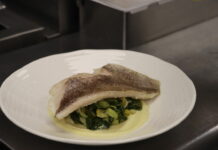In sixth grade, our teacher Ms. Smith gave us an assignment: choose a topic we were crazy about and research it in depth in order to write “an advanced theme.” This was my first research paper, and I took the assignment very seriously. Which of my many passions deserved such intense attention? Dogs? “American Top 40”? “Little House on the Prairie”?
When it came right down to it, candy was a natural choice. After all, I thought, for years I’d been trolling through the glass candy counter at my dad’s pharmacy, picking out Sky Bars, braided Marathons and day-glo pink Good & Plentys from the everyday Milky Ways and Snickers. I made trips to Glauber’s, Wockenfuss and the candy counter at Hutzler’s to select Swedish Fish and fruit slices. I knew to eat Special Darks before any of the other Hershey Miniatures in the bag, to avoid the raisins that hid under chocolate in an otherwise perfectly good box of bridge mix, and to forsake sour balls in favor of glossy hard candy with a chewy center. And while my family didn’t make candy (with the exception of an experiment with candy molds and melted chocolate that all of us deemed boring), I had heard enough of my grandmother’s stories to know that taffy got pulled and fudge reached something called a “soft ball stage.”
I tackled my topic with gusto, detailing the differences between hard candy and buttercreams, penuche and peanut brittle. I brought examples from Wockenfuss for my class to sample. And because every good research project necessarily merits a field trip, I arranged one.
At that time I didn’t know that Goetze’s Candy Co. in East Baltimore began as the Baltimore Chewing Gum Co. in 1895. Heck, it wasn’t until my parents mentioned it that I realized that the company that made caramel creams, the round caramel candies with the white centers also known as bull’s-eyes, was located in Baltimore, even though it was a stone’s throw from my Aunt Stella’s house on East Avenue. And I loved caramel creams, the slim flat packaging made shiny by cellophane, the way the powdery center disintegrated when you bit into it—and the way the caramel had an almost fruity flavor and always stayed soft, no matter how long the last candy had been sitting in the cupboard. Once I found out caramel creams were made locally, there was no stopping me.
With Eloise-like confidence, I announced to Ms. Smith that I wanted to take the class to the candy factory and she promptly sent me to the principal’s office— not as a punishment, but to use the phone in Mrs. Kubick’s office to make arrangements.
Principal Kubick wore St. John-like knit suits, high, beauty-shopped blond hair and even higher heels. She didn’t use the overhead fluorescent lights in her office. Instead, there was just a desk lamp that illuminated a milky glass stem vase with a single yellow rose. It was almost too dark to see the phone number we looked up in the Yellow Pages, but with Mrs. Kubick’s manicured nail holding the place, I dialed the number on the heavy black office phone and explained myself to the person who answered, and again to the person she connected me with and a third time to someone else, before Mrs. Kubick took over. One chilly morning a week later, my class took a school bus to 3900 Monument St.
My memories of Goetze’s are naturally hazy, marred by time and numerous sugar rushes since then. But I remember a bright warehouse-like room with high windows. I remember hairnets, concrete floors, conveyor belts and vats of bubbling caramel and cream filling. I remember pointing at machines that stretched caramel of all different colors—red, almost black, regular toffee brown—into long sheets and giggling as we watched the rolls of candy cut into small slices before being wrapped up in red and white cellophane. And I remember leaving the building with more bags of candy than I’ve ever carried in my life. More than Halloween, Easter or Christmas.
I was reminded of this experience this fall when bags of caramel creams began appearing in the grocery store around Halloween. I bought a bag and then, on impulse, I decided to drive right to the source to see how my memories held up.
Pulling to the curb across from the factory, it was hard to believe it had been 30 years since I last stood in front of this building, backed by elevated railroad tracks and utility poles, ready to board a school bus, all that candy in my arms. And as I scanned this stretch of Monument Street, where blocks of boarded-up rowhomes evolve into commercial strips and 18-wheelers barrel by in clouds of exhaust, it was hard to believe that any sweetness could come from here. There was no smell of sugar in the air, no hint of what goes beyond smoked glass doors save the large red and white sign with the Goetze name, a flower over the “o” where an umlaut might be, and the tag phrase “pronounced ‘Gets’” written below.
The building was white, though in my memory it was gray and situated on the other side of the street. The slender maple trees bordering the hedge and chain-link fence were surely too young to have been there in 1980. And how could I not have remembered the small sign with an image of a wrapped caramel cream and the numbers 3900 picked out in red, like a pub sign, only with candy instead of black swans or mugs of beer?
I looked at the bag of candy, still unopened on the car seat, and wondered if my memories of them, too, were tarnished by time. I unwrapped a caramel, popped it into my mouth, chewed and waited. If I had expected an explosion of recall prompted by caramel, I would have been disappointed. There was no clear vision of the inside of the factory, no buried memory of tour guides or secret formulas. I didn’t remember whether I was wearing my favorite Levi’s corduroys or who I sat next to on the bus. All I got was caramel: sweet, chewy and slightly fruity. But that was enough.




